Gerhard Richter Is A Famous Painter Of Expensive Paintings
by Jane Hu

Right now an exhibit called “Richteriana” is on exhibit at Postmasters, a gallery located in West Chelsea. As the title suggests, the exhibit is by no means a straight-up reification of Richter’s status as a father of conceptualist painting. Nor, however, is it a disavowal of his significance. Instead it’s something much more interesting: an attempt to look at the different forces — the buyers and sellers, critics and academics and museums — that establish the “worth” of an artist.
Sell the story of an artist, and you might just sell a painting too. The particular stories that have cultivated Richter’s status as Germany’s most heralded living artist now occasion Richter paintings to sell for as high as $20 million.
Six artists contributed to the exhibit (which remains up through June 16th): Greg Allen, David Diao, Rory Donaldson, Hasan Elahi, Fabian Marcaccio and Rafael Rozendaal. Each engaged with a different aspect of the artist’s catalogue, from which there was plenty to choose, as Richter, famously, moved among aesthetic practices that seemed, at least initially, to be incompatible.
While Richter began his career painting representationally, his later work belongs primarily to the world of abstractionism. But it wasn’t a straight march. Along the way there was enough toggling back and forth that defining the “Richter sensibility” is difficult, And the exhibit, to its credit, doesn’t try to simplify this complexity into a story of linear progression. The Bildung here isn’t one of continuous progress, but of interruption, reversal and precarity.
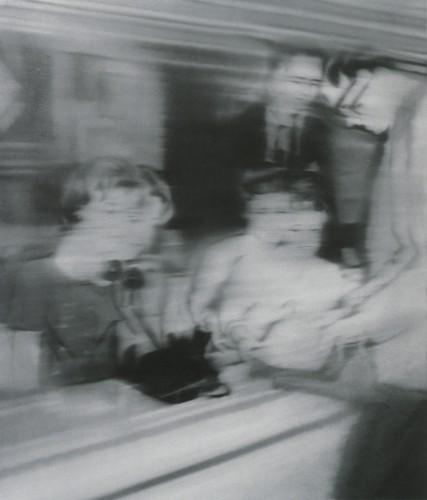
Gerhard Richter, “Reisebüro” (1966), 150 cm x 130 cm, oil on canvas
In 1966, a few years prior to Richter’s first experimentations with abstractionism, the artist declared: “I steer clear of definitions. I don’t know what I want. I am inconsistent, non-committal, passive; I like the indefinite, the boundless; I like continual uncertainty.”
Buyers and sellers are less impressed by uncertainty, though. And along the way Richter’s work has gone from the “indefinite and boundless” to a safe and worthwhile monetary investment. These days, the artist’s fame is largely enforced through one’s immediate recognition of what defines him: colorful squares, abstract swipes, blurry paintings of black-and-white faces. Indeed, it is Richter’s most recognizably “Richter-esque” paintings that sell for the most these days. As Felix Salmon noted for Reuters, a middle-market (ranging from $1–5 million) Richter piece would include “apartment-sized, instantly-recognizable paintings which look nice above the fireplace.” Richter sells precisely because he doesn’t shock; he sells when he’s predictable. Oh, Richter of extreme conceptualist rigor! When did you become so all-round middling?
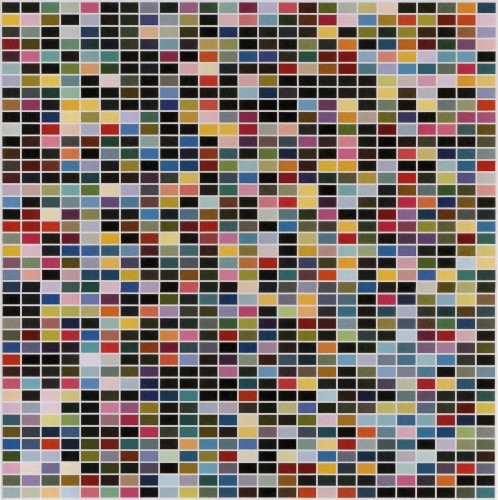
Gerhard Richter, “1025 Farben” (1974), 254 cm x 254 cm, enamel on canvas
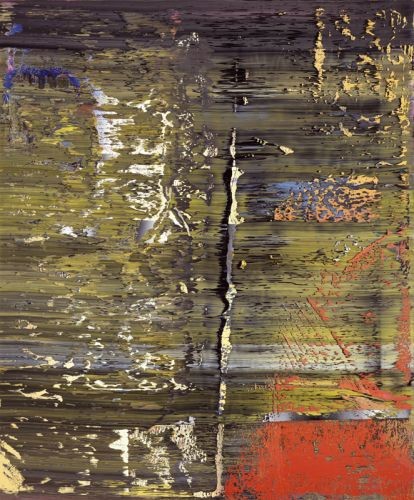
Gerhard Richter, “Abstraktes Bild” (1988), 120 cm x 100 cm, oil on canvas
***
But the story that has attached itself to Richter’s work comes at least in part from the artist himself. Richter is, as many have noted, a careful steward of his mythology.
A look at Richter’s official website will reveal the intense and diligent care with which he has taken to document his sprawling catalogue. The detail of Richter’s online archive inspires an image of the artist’s legitimacy, even though its objectivity and truth value has often been put into question. As Dietmar Elger’s 2009 book Gerhard Richter: A Life in Painting suggests:
This catalog is one of Richter’s ongoing projects — a work in itself — and has long been a subject of controversy. Catalogues raisonnes are ordinarily assembled by scholars, who strive to document every authentic work by a given artist, and are organized chronologically. For Richter, the point is less to establish authenticity than to establish a trajectory within the artwork that he deems acceptable.
To this end, the artist has destroyed or painted over many past works, in order, presumably, to maintain a narrative about his artistic trajectory that satisfies his present sense as a painter. Richter knows as well as anyone that art history traffics in selling a story, as much as it does in telling an image. While the first half of his career produced paintings that tried to approximate photographic realism, he later increasingly turned to abstraction. And in doing so, no matter what other aesthetic reasons he may have had, Richter not only has revised his own biography, but those of his paintings as well.
When describing his practice, Richter deals in phenomenal superlatives. His descriptions are sustained by rhetoric that deals in metaphysics and transcendence: “One has to believe in what one is doing, one has to commit oneself inwardly, in order to do painting. Once obsessed, one ultimately carries it to the point of believing that one might change human beings through painting.” In the late 80s, far into his experimentations with abstractionism, Richter was still speaking about the creative process in terms of an engaged, spiritual delirium: “Art is the pure realization of religious feeling, capacity for faith, longing for God.” This kind of language seeks to boil art down to affect, and is almost always (surprise!) used by — and to describe — the visionary status of white male genius. In any field, the artists that have sold the best — and rested in greatest posterity — are the Great Men who suffered to represent their time. Gustave Courbet, Paul Gauguin, Pablo Picasso, Jackson Pollock, Willem de Kooning, and before I start listing an entire canon… just stop and think of all the self-portraits by famous painters and you’ll get an idea of how often the male artist has turned to religious iconography in order to portray their personal state of creative inspiration.
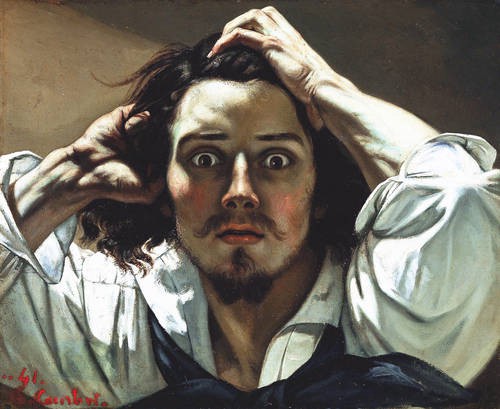
Gustave Courbet self-portrait, “The Desperate Man” (c. 1843–1845)
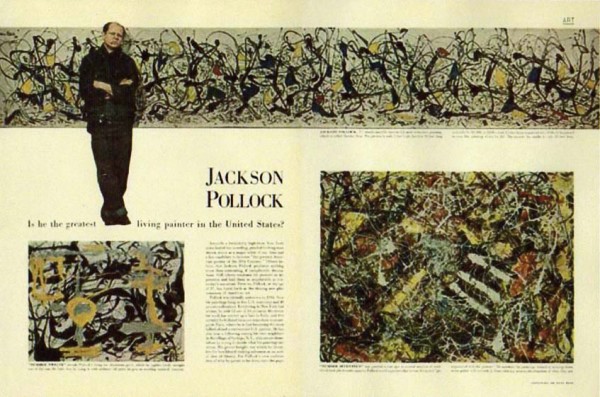
“Jackson Pollock: Is he the greatest living painter in the United States?”
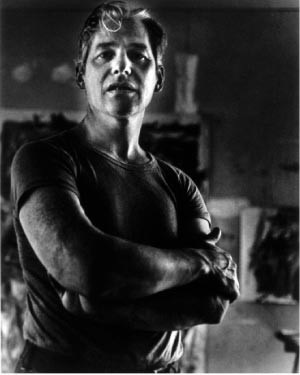
A young Willem de Kooning
The tortured, tragic, reclusive, reticent, painfully cryptic Greatest Living White Male Artist. How many more will there be to glorify?
***
The story of Richter has been codified through constant gallery retrospectives; auctions; a hefty archive of articles, essays, and books; even a documentary. Such canonization, these days, inevitably turns to commodification. The artist broke his own personal record in the fall of 2011 when one of his non-representational compositions yielded over €15 million at a Sotheby’s auction.
The amount of attention paid to Richter has made him one of the most important artists of the last century. It has also made him one of the most valuable. In July 1986, Joseph W. Alsop opened his NYRB essay on “Art into Money” with the following:
Almost weekly, the newspapers report new record prices for works of art. Monthly, expensively glossy magazines bulging with dealers’ advertisements, chronicle the art market’s latest trends with respectful minuteness. And every year, art’s present peculiar status, as conspicuously high-priced merchandise, inspires more and more books of one sort or another — most recently two breathless accounts of the takeover of Sotheby’s auction house by an American syndicate headed by Alfred Taubman.
Alsop goes on to discuss how people are still (still! then!) shocked to hear about the branding of artworks for monetary purposes. It was news to them then, and apparently it’s still news to us now. The story of auction house capitalism is an especially well-told one since, for some reason, people with the means to be interested in Art are often those most able to avoid the reality that their aesthetic tastes are driven by class, and as such, money. When the story breaks, it’s always the same one: sometimes the artists’ names change, and more often than not prices are on the rise. Surprise.
Salmon’s recent piece on Richter’s status in the art market took the Sotheby’s-is-corrupt narrative one step further by looking at how the painter has been commodified not only by auction houses, but by banks themselves. As Salmon explained:
Jonathan Binstock is the head of Citibank’s art advisory and finance operation — the shop which was famously founded by Jeffrey Deitch. Recently, he put out a four-page research report on Gerhard Richter. According to Binstock’s report, Richter “has recently emerged powerfully as the next great market force among the tradition of 20th century painters including Pablo Picasso, Willem de Kooning and Andy Warhol”. What’s more, “it is clear that he is in the process of being catapulted to a rare and illustrious realm of authority.”
The Reuters piece also includes a chart that illustrates said catapulting. Salmon goes on to describe how Binstock’s chart has turned Richter, quite explicitly, into something investable: “Binstock is very much part of the way in which the art world is turning individual artists, like Gerhard Richter, into asset classes.” Further, Richter is investible not only because his artistic trajectory has been solidly plotted out in terms of its financial reliability, but so has his future.
While I’m hesitant to agree with much of what Felix says about Richter’s art-as-art (his comparison of Richter to Picasso, de Kooning, and Warhol as “no slouch […], but he’s not in their league, and never will be” feels too easy), what Salmon seems to be getting at isn’t the inventiveness, but the oft-noted banality, of Richter’s paintings. If Salmon (as well as the art establishment) have counted on Richter to deliver signature Richter, “Richteriana” wants to give us something different.
***
This is in perverse keeping with the artist’s own methods of creation. Richter is constantly revising, tearing apart and layering upon his old work, to bring the viewer something different. Often, Richter uses the same canvas multiple times to bring this message home. Repainting over his more photorealistic pieces, Richter drags large squeegies or spatulas across these paintings to yield surprising and spontaneous leakages and patterns of color. What does it all mean? And can it mean more than one thing? Whatever it is, it says the opposite of what Richter talks about when describing one’s gut-level aesthetic response to art. To use a broad squeegie (spanning more space than a human hand ever could) is to try to erase artistic intentionality through its replacement with disinterested machinery. As early as 1964, the painter announced: “I hate the dazzlement of skill.” In the NYRB, Sanford Schwartz likens these abstract do-overs to “a stunning version of your TV on the fritz” — an analogy that suggests this kind of art is impersonally mediated. All brilliant color, but the stunning stimuli amounts to little meaningful content. The message here might be to destroy all prior messages. “Cutting up the paintings was always an act of liberation,” says Richter about his own practice.
“Richteriana” explores exactly the ways in which abstraction becomes a cover — fuzz and noise — to ignore narrative and context. Each artist draws Richter’s pieces out temporally to suggest that he is, quite fundamentally, an artist of narrative.
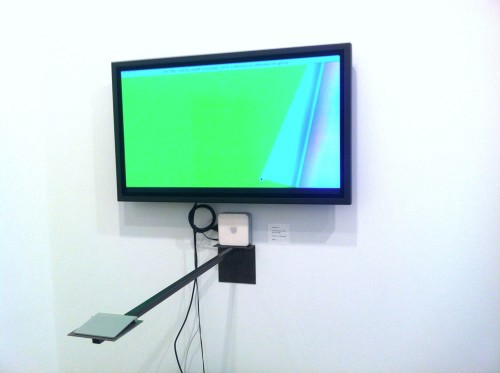
Rafael Rozendaal, www.colorflip.com (2008), interactive online project, color and sound installation view
Rafael Rozendaal’s “www.colorflip.com” works to materialize and draw out the realist effect of Richter’s “Umgeschlagenes Blatt” (“Turned Sheet”) series of 1965–67By actually getting to flip the pages of Rozendaal’s virtual stack (an experience that could, theoretically, go on forever), our interaction with “www.colorflip.com” is like that of “reading” a colored book. At Postmasters, you can interact with Rozendaal’s piece through a large television screen, which only exaggerates the realism of Richter’s “Umgeschlangenes Blatt.”
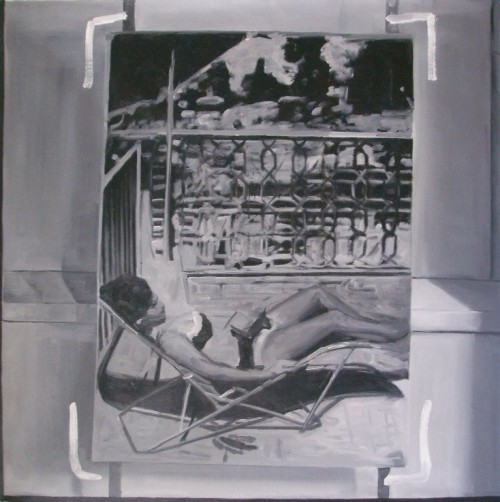
Greg Allen, “Destroyed Richter Painting No. 4” (2012), 43 x 43 inches, oil on canvas
Greg Allen’s “Destroyed Richter Paintings” also plays with seriality, by taking the photographs that Richter took of his paintings before he destroyed them (um, for posterity?) and sent them to a Chinese photo-painting company where they were recreated five times. Not only are these five paintings approximations of Richter’s originals, they are, in addition, approximations of each other. Allen further explains on his blog:
Which is actually one reason I debated not posting images of the Destroyed Richter Paintings paintings I put into the show. One of the real drivers of making the paintings was to approximate the experience of standing in front of paintings that could now only be seen through photos. Or transparencies. Or JPGs. And to measure what the difference is between these different modes of mediated perception.
While one of Allen’s aims is to try to recreate the experience of encountering Richter’s original paintings, he also makes it obvious that these are indeed recreations. These Chinese facsimiles actually include the bordering context with which these Richter’s photographs are found.
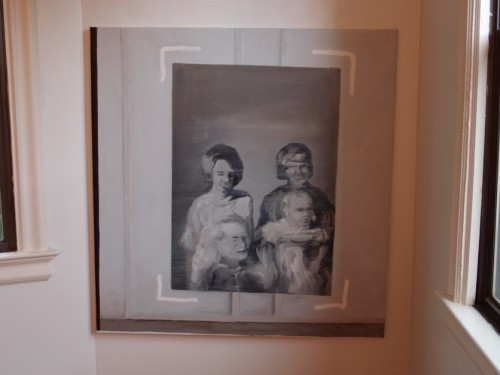
Greg Allen, “Destroyed Richter Painting #05”(2012), oil on canvas
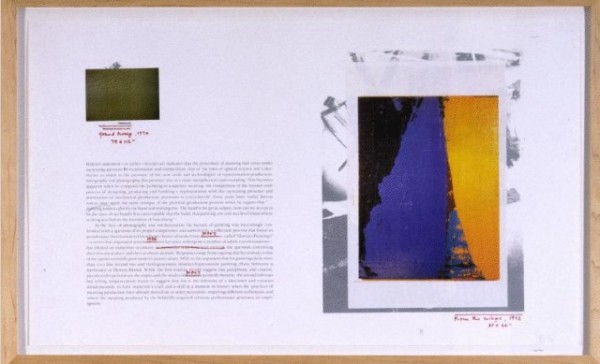
David Diao, a detail from “Synecdoche,” 1993, color xerox, marker and silkscreen on paper, 5 separate sheets, overall 84 x 84 inches
David Diao’s piece “Synecdoche” explicitly plays with narrative by enlarging and framing a recent Artforum essay by Benjamin Buchloh (a Harvard academic that has closely followed Richter for the past two decades), only to cross out and rewrite over certain words with red ink. Notably, “Richter” is replaced with “Diao.” Most of the dates are also striked out and written over with numbers that, presumably, align with Diao’s career:
In the face of photography and mechanization the facture of painting was increasingly confronted with a question of its proper competence and authenticity a reflection process that found its penultimate theorization in Greenberg’s theory of modernism. Richter’s [Diao’s] so-called “Abstract Paintings” — a series that originated around 1976 [1966] and has since undergone a number of subtle transformations — has elicited on numerous occasions, in particular with American viewers, the question concerning their historical place and their aesthetic attitude.
Diao also places his own paintings over the ones Buchloh has chosen to represent Richter’s practices (though not completely, so that, like the artist’s crossed-out name, Richter’s paintings also show beneath Diao’s). For instance, Richter’s “Ohne Title” (1984) is covered over by Diao’s “Wealth of Nations” (1972), which is also included in the Postmasters exhibit. The discrepancy between the dates is telling. The story here is that Diao’s art precedes much of what Buchloh, among others, heralds Richter as innovating. Indeed, what Diao says about his “Wealth of Nations” phase indicates that his “Richter-like” techniques emerged even earlier than 1972:
Like many others, I was looking for mechanical means to circumvent the tyranny of the painter’s hand. Moving past sponges and window scrapers by early 1969, my instruments of choice were cardboard tubes readily available from the curbside of the neighborhood. My thought was to marry the size of the mark with the size of the support and by scaling up the “brush” enlarge the scale.
Another Diao painting even covers part of Buchloh’s text. “Synecdoche” engages in a rewriting of art history (and what is history but rewriting?) that makes the rewriting explicit.
While Allen and Diao want to make clear the rewriting that comes with the chronicling of art history, Hasan Elahi’s “Tracking Transcience” piece plays with how media can make art in real time. After being placed on an FBI list of suspected terrorists, Elahi began playing the surveillance game better than those who were supposedly watching him. Since 2002, Elahi has been tracking — both visually and geographically — his own life, and displaying it publically — by logging all the beds, airports, meals, washrooms of his day-to-day existence. Like Richter’s “Atlas” and online catalogue, Elahi’s piece tells a kind of autobiography through archives. Unlike Richter, however, Elahi’s story is instantaneous rather than revisionist. Newer and faster media allows us to tell stories as they are happening.
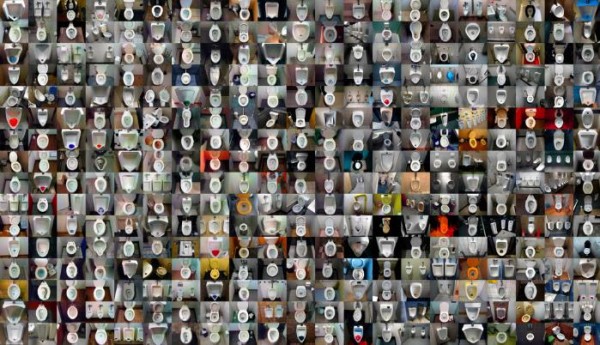
Hasan Elahi, a detail from “Tracking Transcience: Security & Comfort” (2012), 60 x 210 inches, c-print in 7 sections
With the work of such analytically minded artists as Diao and Allen included, “Richteriana” cannot help but sometimes feel like a criticism of Richter’s main critics. While art critics like Benjamin Buchloh and Robert Storr, unquestionably intelligent and searching thinkers in their own right, have spent a career lauding Richter by emphasizing his status as artistic innovator, there are others who, however quietly, beg to differ. Diao’s “Wealth of Nations” and “Synecdoche” are currently on display on the walls of Postmasters with an alternate story to tell: art always moves faster than art criticism writes it. A lot of “innovation” gets lost in the time it takes to write about it.
Jane Hu is in the middle of a story. Images from “Richteriania” exhibit courtesy of Postmasters.
